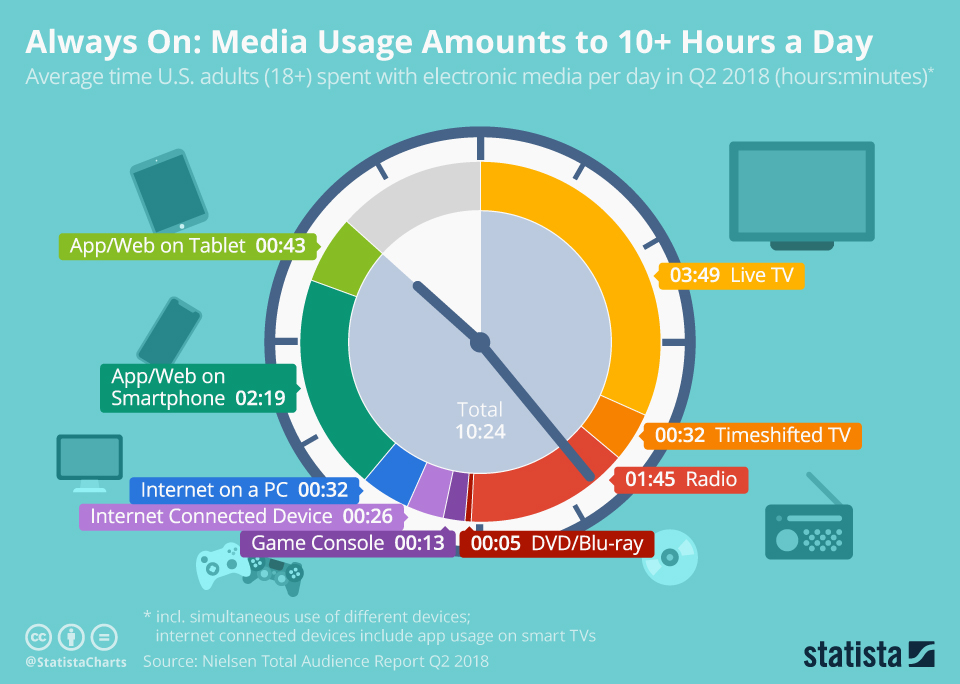What does it mean to have a sedentary lifestyle?
A sedentary lifestyle is generally characterised by a lack of regular physical activity. According to the World Health Organization (WHO), we should practice physical activity at least 30 minutes a day, 3 days a week. Long- and short-term consequences of a sedentary lifestyle can deteriorate our quality of life and reduce our life expectancy. So it is important to listen to our body so that we can timely change habits affecting its harmony.
We may think that adopting a sedentary lifestyle is down to the type work we do, however the reality is that technology is to be blamed for this. According to a Nielsen’s report, the average American adult spends nearly 11 hours of the day using electronic devices.
 You will find more infographics at Statista
You will find more infographics at Statista
Assuming we roughly sleep 8 hours a day, this may leave us only 5 hours to do other activities. It is likely that we spend the remainder of the day eating, commuting, doing house chores or enjoying our hobbies. This rough estimation makes it clear we are developing strong sedentary behaviours that will likely remain unchanged as technology evolves.
Sedentary lifestyle risks
Sedentarism poses health risks in every stage of our lives but knowing how to mitigate them can save us a great deal of money, suffering and pain down the road. Here are some short-term and long-term consequences of a sedentary lifestyle.
Short-term consequences
Most common short-term consequences of a sedentary lifestyle have an acute impact in our health condition and in some cases are barely perceptible. If corrected, they will not pose any problem in the long run. Some of these short-term consequences are:
- Body weight fluctuation. One of the immediate changes you may not perceive is a sudden change in your body weight. This depends on how active you were as well as the type of physical activity you used to do. Stopping body-building exercises overnight reduces the lean mass in a matter of days and could lead to weight loss. In contrast, halting cardio exercises overnight may increase the fat mass and lead instead to weight gain.
- Bone density loss. Sudden lack of physical activity can also reduce the bone mass a matter of days. Our bones need to be exposed to constant mechanical stress to be able to retain relevant minerals.
- Metabolic changes. Dropping the level of physical activity could quickly slow down our metabolism, impacting our energy expenditure and reservoirs. This means that our body will store more carbs in a form of fat.
- Lung capacity loss. Perhaps a more discreet change is a reduction of the pulmonary function. The breathing is a process controlled by the lung elastic tissue and the diaphragm. Sudden lack of physical activity reduces the effectiveness of the diaphragm, which diminishes the air intake.
- Reduced fatigue threshold. A more short-term and perceptible change is the fatigue. Daily activities and insignificant tasks can become challenging and fatiguing. This happens because our muscles start to accumulate higher levels of lactic acid, responsible for the fatigue.
- Increase sleep time. A prolonged sedentary behaviour can elevate the risk of insomnia and sleep disturbance short-term. This could happen due to our bodies not getting fatigued enough during the day.
Long-term consequences
A perpetuated sedentary behaviour can give room to chronic non-communicable conditions and impact negatively our lives. In general, lack of physical activity can increase the risk of:
- Cardiovascular diseases. Cardiovascular diseases are the main cause of mortality worldwide and one of its most common risk factors is the lack of physical activity. The most common disorders are coronary disease, hypertension, heart failure and ischaemic disease, amongst others.
- Obesity. Some people are more prone to gaining excessive weight in the absence of physical activity than others. This depends on how fast your metabolism is and also the diet you have. Obesity is generally a consequence of very slow metabolisms and constant oversized meals.
- Type 2 Diabetes. Changes to the diet and reduction of physical activity levels have lead many people to develop insulin resistance, disrupting the normal metabolic process in the body.
- Cancer. Although less common, a prolonged sedentary behaviour can increase the risk of colon, endometrial and lung cancer. Experts have found that the risk increases as we spend more time sitting.
How many calories does a sedentary person burn?
We burn calories all the time, even while we sleep, but how much we burn depends on our weight, sleep time, metabolism and level of physical activity. So if you are a couch potato and do little to no physical activity, it means your body operates solely on the basal metabolic rate (BMR).
The BMR is the minimum caloric energy required to keep your essential organs running, and is unique to each person. Calculate your own basal metabolic rate with the calculator below:
In theory, there is not a standard or gender-specific BMR as (and as mentioned above) it depends on each person’s body characteristics. Instead the body mass index (BMI) is used as an indicator to gauge how much energy you should be expending based on your body architecture. To calculate your BMI, use the calculator below:
However, if you are more active, your total energy expenditure during the day may be higher based on the activities you do. Check this calculator to see how many calories you burn in different activities:
Tips to become more active at work and fight short-term consequences of a sedentary lifestyle
There are some very simple activities that you can do in your workplace to keep active. Here are some tips to stay more active in your workplace and avoid a sedentary lifestyle:
- Use a standing desk: In a regular eight-hour workday, you should be on your feet for at least two hours . In this sense, some companies are incorporating standing desks so that their employees can remain standing longer.
- Take active breaks: On the other hand, if you have a conventional desk, you can move your feet by rotating them to both sides, or you can put your toes on the floor and raise and lower your feet. It may seem like nothingness itself, but that slightest movement will make a difference at the end of the day.
- Use the stairs: Another of my suggestions is that you forget about the elevator and that you choose the stairs whenever you can.
- Visit colleagues: Also, of all the calls and messages that you exchange with your colleagues, you could choose in some cases to communicate personally with them and go directly to their desk. It does not matter if your partner is only one meter away, what counts is that you will have gotten up from the chair and you will have walked at least two meters. If you have a chance, take 10 minutes every two hours for a walk around the office and then go back to your tasks.
- Fidget: What’s more, those incipient leg movements, called restless leg movements, will also make the difference at the end of the day between being completely still or moving your legs for a bit.
- Use digital resources: There is a plethora of material on the internet you can use to be more active, from digital assistants, mobile apps, to workout routines. Just find the best tool for you and get moving!
You may be interested: Taking breaks at work can boost your vitality and productivity
I always say that you must make a firm decision yourself to have a different and healthier attitude at work and in life in general. There will always be excuses, but time and ways to be on the move in the office, too. Look for the alternatives at your disposal to get your body moving, at least for just a few minutes to ‘sit less and move more’.



Leave a Comment